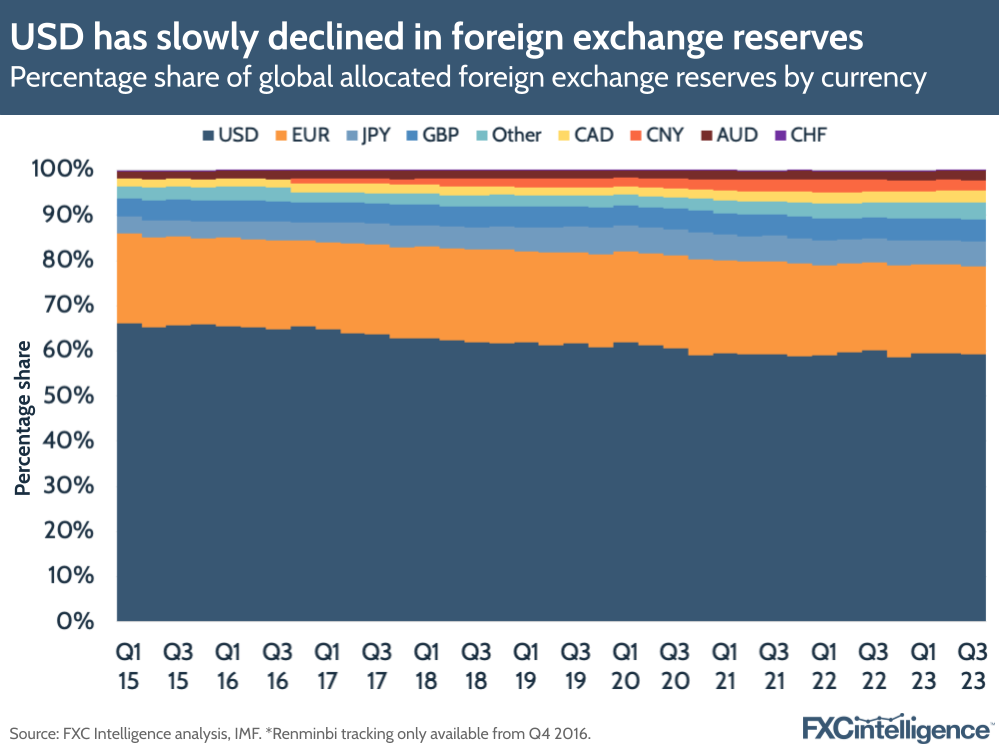- FXC Intelligence has today published a report assessing the perceived narrative that dedollarisation has been accelerating due to the rise of China’s currency, the yuan, in USD’s place.
- The report finds the reality of dedollarisation is much more nuanced and complex than this narrative suggests and is instead indicative of a global trend towards a more decentralised range of financial power.
- This conclusion is supported by evidence from IMF and central bank datasets on foreign exchange reserves, cross-border payments and currencies in Chinese trade.

FXC Intelligence has today published a report assessing the perceived narrative that dedollarisation has been accelerating due to the rise of China’s currency, the yuan, in USD’s place. Dedollarisation, the practice of countries switching away from the US dollar as a reserve currency, medium of exchange or unit of account, has been subject to considerable discussion for some time, with the yuan often cited as the currency countries are instead moving to.
However, the report found that whilst the world is slowly drifting from its reliance on the US dollar as the global second currency, it is not an acute or rapid occurrence and it is not happening due to a strong shift to any single other currency.
Lucy Ingham, Editor-in-Chief and Head of Content at FXC Intelligence said:
“It’s often suggested that countries are stepping away from the US dollar in favour of China’s yuan in a sharp and dramatic shift for the world’s global economy. Our report finds that this narrative is overstated and doesn’t give a true picture of what is really happening.
“Our research shows that dedollarisation is happening, but that it is not simply a shift to the yuan and that it is by no means rapid. It is instead currently on course to be a slow process over the next couple of decades as countries shift to a broader range of currencies, likely to provide greater hedging from future possible geopolitical shocks.
“FXC Intelligence will monitor dedollarisation as it continues to evolve over the next few years through changes to the geopolitical landscape, climate change and migration and report on any significant changes to the current status quo.”
To come to this conclusion, FXC Intelligence assessed available datasets on foreign exchange reserves, cross-border payments and currencies in Chinese trade.
Data from the IMF shows that there has been a decline in the US dollar’s share of global allocated foreign exchange reserves; however, the move is not singularly to CNY but to a broader range of currencies, including the Canadian and Australian dollars, the Japanese yen and British pound.
FXC Intelligence forecasted future growth rates of currency shares in foreign exchange reserves on a linear basis (not taking into account potential reshaping geopolitical and economic factors) over the next decade. This forecast shows that if trends continue as they have done for the past decade, a move away from the dollar is set to be a very slow process and USD will still remain the largest currency for foreign exchange reserves for many decades to come. While the yuan will see continued growth, at current rates it will only reach 6% of global currency reserves by the end of 2034.
Meanwhile, data on cross-border payments from Swift shows a clear rise in the yuan’s share of global customer-initiated and institutional Swift payments over the past few years. However, there has not been a move away from the US dollar over the same period. Instead, this has also seen growth, with the USD rising to 60% of non-Eurozone cross-border Swift payments in November 2023.
There has been a sharp uptick in the use of the yuan for trade to and from China and the US dollar has been losing out at around the same rate that the yuan has been gaining. This suggests that the yuan-specific dedollarisation narrative does meaningfully apply to China’s inbound and outbound payments, even if it doesn’t hold out on a global scale.
To read the report in full, click here.